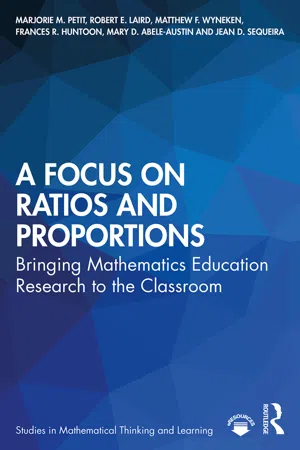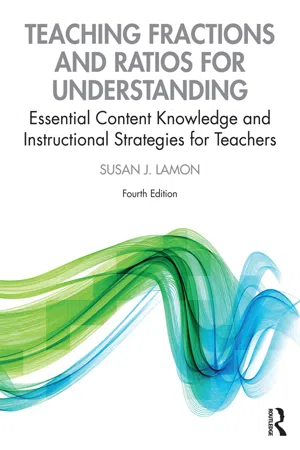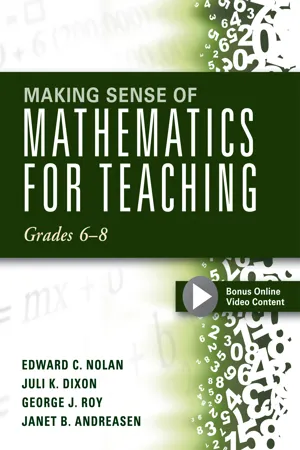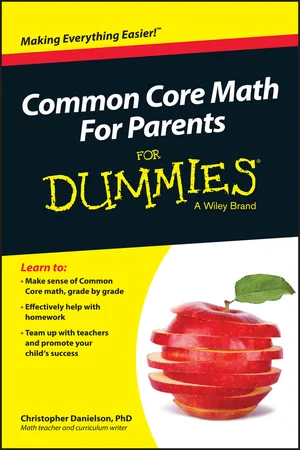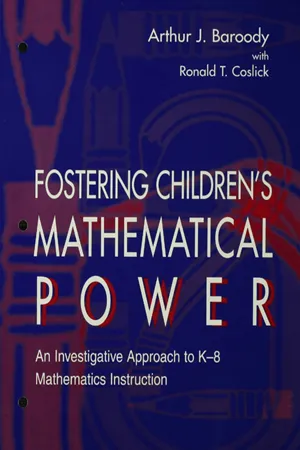Mathematics
Ratio
A ratio is a comparison of two quantities, typically expressed as a fraction. It represents the relationship between the two quantities and can be used to compare sizes, amounts, or values. Ratios are often used in mathematical problems, such as in proportions and in solving for unknown quantities.
Written by Perlego with AI-assistance
Related key terms
Related key terms
1 of 4
Related key terms
1 of 3
12 Key excerpts on "Ratio"
- eBook - ePub
A Focus on Ratios and Proportions
Bringing Mathematics Education Research to the Classroom
- Marjorie M. Petit, Robert E. Laird, Matthew F. Wyneken, Frances R. Huntoon, Mary D. Abele-Austin, Jean D. Sequeira(Authors)
- 2020(Publication Date)
- Routledge(Publisher)
kx and similarity.This chapter includes discussions on:- the meaning of a Ratio,
- two different interpretations of Ratios,
- understanding rates,
- the different language and notation used to communicate Ratios and rates that may interfere with student understanding,
- the meaning of a proportion and what is meant by a proportional relationship.
Figure 1.1 How multiplicative concepts develop across mathematics curriculumRatios
A Ratio is a multiplicative comparison of two or more quantities or measures. These comparisons can be part-to-part, such as 8 students to 2 adults or 2 cups of sugar to 5 cups of flour, or they can represent part-to-whole situations like 8 girls to 24 students in a class. Regardless of the situation, Ratio comparisons are always related multiplicatively. For example, in the Ratio 8 students to 2 adults, there are 4 times as many students as adults. One can describe this relationship in several ways such as:- 4 students for every 1 adult,
- 1 adult for every 4 students,
- the number of adults is 1 4the number of students.
Two Interpretations of a Ratio
Two related but different ways to form a Ratio are shown in Figure 1.2 . The first is by joining or composing two quantities in a way that “preserves a multiplicative relationship,” and the second is multiplicatively comparing two quantities (Lobato, Ellis, Charles, & Zbiek, 2014, p. 18).Figure 1.2 Two types of RatiosRatios as Joining Two Quantities
As introduced already, one interpretation of a Ratio is the joining of two quantities in a way that preserves a multiplicative relationship. In this interpretation, a certain number of one quantity together with a certain number of another quantity creates a composed unit (Beckmann, 2014). So we can think of this Ratio interpretation as a Ratio as a composed Unit. Figure 1.3 - eBook - ePub
- Chris Nord(Author)
- 2021(Publication Date)
- Chemeketa Press(Publisher)
CHAPTER 6Proportional Reasoning
What Is a Number?
The world is a complex and dynamic system of interlocking parts. No person or object is completely unaffected by the rest of the world, and the world is not completely unaffected by any individual person or object. Everything is part of a system. When analyzing systems, we use various types of measurement to describe a part of the system with a number value. Because everything is part of a system, we relate things to one another by comparing them.In this section, we begin to explore how various measurements of different parts of a system are connected to and affected by each other.6.1 Ratios and Rates
In Chapter 3 , we introduced the set of Rational numbers. When we use the word “Rational” to describe people, ideas, or decisions, we mean that they are reasonable. For example, we might say “in response to the increasing cost of education, the college made a Rational decision to invest in producing affordable textbooks.”When we use the word “Rational” to describe a number, however, it means something quite different. A Rational number is a number that is a Ratio of two integers.A. Introduction to Ratios
ARatiois a specific type of quotient. It compares two numbers and determines their relationship to one another.RatioA quotient that may be used to compare two numbers that represent measurements, amounts, or quantities.The relationship of the two numbers in a Ratio can be expressed as a fraction or in a sentence. For example, since Katie McWilliams is 74 inches tall and Mikayla Pivec is 68 inches tall, we can say that the Ratio of Katie’s height to Mikayla’s height is . We can also use the word “to” in place of a fraction bar:The Ratio of Katie’s height to Mikayla’s height is 74 to 68.When we express a Ratio as a fraction, that fraction can be simplified. Because and are equivalent fractions, it would also be correct to say that the Ratio of Katie’s height to Mikayla’s height is , even though Katie is not 37 inches tall, and Mikayla is not - eBook - ePub
Well Played, Grades 6-8
Building Mathematical Thinking Through Number and Algebraic Games and Puzzles
- Linda Dacey, Karen Gartland, Jayne Bamford Lynch(Authors)
- 2023(Publication Date)
- Routledge(Publisher)
Chapter 4 Ratios and Proportional Relationships DOI: 10.4324/9781032683027-4 What's the Math? Understanding the concepts involved in Ratios and proportional reasoning is essential to continued study in both mathematics and the sciences (Common Core Standards Writing Team 2011a). In math, proportional thinking underpins such ideas as slope, similar figures, and trigonometric functions, while in science examples include acceleRation, density, and equilibrium. Ratios and proportional relationships also pervade our daily lives, such as when we shop, cook, measure, or listen to the news or weather. It’s clear, therefore, that students must develop conceptual understanding and proficiency in these topics. A Ratio is used to relate two or more quantities. The quantities may have the same units, such as cups of oil to cups of vinegar, or they may have different units, such as miles to hours. There are many ways to express Ratios—for instance, four students for every one adult, four times as many students as adults, four students per one adult, or four students to one adult. The phrase, times as many as, can help students to remember the multiplicative relationship between the quantities, which is a challenging concept (Lamon 2012). Students can find equivalent Ratios through additive thinking, but it is not an efficient method when the gap between numbers widens. Two students’ responses to the question If the team has 3 gloves for every 6 baseballs, how many baseballs will the team have for 9 gloves? are shown in Figure 4.1. Note that, though both students arrived at the correct answer, Student A clearly understood the idea of what it means to have 3 gloves for every 6 baseballs but used additive thinking, while Student B demonstrated multiplicative thinking. It is tempting to simply mark a student’s work as correct if the answer is accurate, which would occur in both instances with these exit cards - eBook - ePub
Teaching Fractions and Ratios for Understanding
Essential Content Knowledge and Instructional Strategies for Teachers
- Susan J. Lamon(Author)
- 2020(Publication Date)
- Routledge(Publisher)
• Ratios may have a zero as their second component, but fractions are not defined for a denominator of zero. For example, if you report the Ratio of men to women at a meeting attended by 10 males and no females, you could write 10:0.• A fraction is an ordered pair; that is, if you reverse the order of a and b in the fraction, you have written a completely different fraction. The same is true with Ratios. 4 boys: 3 girls and 3 girls: 4 boys are different Ratios and they may not be used as if they are interchangeable. However, the Ratios 4 boys: 3 girls and 3 girls: 4 boys give you the same information about a situation.a b• Ratios arithmetic can be very different from fraction arithmetic. Consider this problem: yesterday Mary had 3 hits in 5 turns at bat. Today she had 2 hits in 6 times at bat. How many hits did she have for a two-day total?• Mary had 3:5 + 2:6 = 5:11 or 5 hits in 11 times at bat. If we were adding fractions, we would never write3 5+2 6=5 11!Researchers are still trying to capture the difference between Ratios and rates; however, when we consider the many ways in which the words are used in both mathematical and nonmathematical circles, definitions can prove unsatisfactory. Part of the difficulty is that everyday language and usage of rates and Ratio is out of control. The media have employed the language of Ratios and rates in many different ways, sometimes inconsistently, sometimes interchangeably. Students are exposed to less-than-correct usage and terminology, and it is no easy task to reconcile precise mathematical ideas with informal, colloquial usage. In order to help children understand real contexts in which they encounter Ratios and rates, teachers must be prepared to help children analyze each situation individually. In this chapter, we will look at some of the issues and nuances that require discussion in the classroom. - (Author)
- 2023(Publication Date)
- Kaplan Test Prep(Publisher)
rt. The rate will always be the something per something, the distance value will match the units in the first part of the rate (“something per . . . ”), and the time value will match the units in the second part of the rate (“ . . . per something”).A Ratio is a comparison of one quantity to another.- When writing Ratios, you can compare one part of a group to another part of that group, or you can compare a part of the group to the whole group.
- If you have a bowl of apples and oranges, you can write Ratios that compare apples to oranges (part to part), apples to total fruit (part to whole), and oranges to total fruit (part to whole).
- Ratios can be expressed using colons (3:5), fractions , or words (3 to 5).
- Ratios are typically expressed in lowest terms and convey relative amounts—not necessarily actual amounts.
- If there are 10 apples and 6 bananas in a bowl, the Ratio of apples to bananas would likely be expressed as on the ACT rather than as .
- If you know the Ratio of apples to bananas and either the actual number of apples or the total number of pieces of fruit, you can find the actual number of bananas by setting up a proportion, but if you only know Ratios and no actual numbers, you cannot calculate any actual numbers.
- If the Ratio of apples to bananas is and there are 10 apples, then you can use the common multiplier 2 (because 5 × 2 = 10) to determine that there must be 3 × 2 = 6 bananas.
- If the Ratio of apples to bananas is and there are 16 pieces of fruit, you can set up a proportion to find the number of bananas:
- If the only information provided is that the Ratio of apples to bananas is and the Ratio of apples to total fruit is
- eBook - ePub
Making Sense of Mathematics for Teaching Grades 6-8
(Unifying Topics for an Understanding of Functions, Statistics, and Probability)
- Edward C. Nolan, Juli K. Dixon(Authors)
- 2016(Publication Date)
- Solution Tree Press(Publisher)
CHAPTER 2Ratios and Proportional Relationships
This chapter transitions the focus on Rational numbers in terms of fractions to Rational numbers as Ratios and proportions. A fraction is a Rational number because it describes a Ratio of two numbers. In a fraction , the numerator, a , describes the number of equal-size pieces of the whole, and the denominator, b (where b is equal to 0), indicates the number of those pieces needed to make the whole. A Rational number that is not a fraction can also be described as ; however, a and b (b ≠ 0) do not describe a part-to-whole relationship. While the focus of Rational numbers was on fractions in the previous chapter, Ratios are explored in this chapter.Comprehending Ratio and proportionality concepts empowers students to solve problems that include a number of different real-world applications. In providing problems to solve involving Ratios and proportions, you support students to develop proportional reasoning (Kilpatrick et al., 2001). Proportional reasoning includes the understanding of the interrelationship of two quantities and how a change in one connects to a change in the other.The Challenge
The initial task in this chapter (see figure 2.1 ) provides an opportunity to apply proportional reasoning in a real-world context. Take a moment to complete the task before continuing on.Figure 2.1: Crowded restaurant task.A restaurant was set up in two sections to accommodate different parties. In one section of the restaurant, there was a party of 18 people and there were enough seats for 34 people. At the same time, the other section of the restaurant had 14 people with seats for 30. Which section was more crowded? How do you know?How did you make sense of this task? What type of solution process did you use—numerical or pictorial? As you examine this task, you might notice that each section has sixteen empty seats. Does this mean that the sections are equally crowded? Why, or why not? How does each seat count toward crowdedness? The first section has more people but also more seats. How does this information affect crowdedness? Consider the representation in figure 2.2 (page 46 - Christopher Danielson(Author)
- 2015(Publication Date)
- For Dummies(Publisher)
Sixth grade is a transition year. Physically, many sixth graders are transitioning from elementary to middle school and from childhood to adolescence (at varying rates and starting times, of course). It’s also a year of mathematical transition, too. During the elementary grades, the focus was on addition and subtraction relationships. In sixth grade, the focus shifts to multiplication and division relationships.Students enter sixth grade already knowing how to multiply and divide, but they’re more likely to think about comparing numbers, for example, using addition and subtraction than using multiplication and division. In sixth grade, students make this transition. The main tool for doing so is the idea of Ratio.In addition to studying Ratios, sixth graders study a little bit of algebra, they work on areas of polygons by comparing to the area of a rectangle, and they begin to study more sophisticated data analysis tools. This chapter has you covered with these sixth-grade math concepts.Understanding Ratios
A Ratio is a comparison of two numbers that depends on the multiplication relationship between them. Here are some examples of Ratios:- A recipe for orange juice calls for 3 cans of cold water for each 1 can of frozen concentrate.
- The city of Saint Paul requires 5 parking spaces for every 1,000 square feet of retail space in a new development.
- A certain shade of green paint requires 3 parts of blue paint for every 2 parts of yellow paint.
Telling fractions from Ratios
A Ratio compares two numbers by using the multiplication relationship between them. You can write a Ratio in three different ways:- 3 to 2
- 3:2
In each case, you can read the Ratio as three to two . Sixth graders typically work with the first two of these forms rather than the fraction form because of important, but subtle, differences between fractions and Ratios.You can think of a fraction as a number. The fraction has a place on the number line — halfway between 1 and 2 (see Figure 11-1- eBook - ePub
Fostering Children's Mathematical Power
An Investigative Approach To K-8 Mathematics Instruction
- Arthur Baroody, Arthur J. Baroody, Jesse L.M. Wilkins, Ronald T. Coslick(Authors)
- 1998(Publication Date)
- Routledge(Publisher)
- investigate relationships among fractions, decimals, and percents” (p. 87).
12•1 RatiosAs Figure 12.1 implies, an accurate understanding of Ratios is a key aspect of mathematical literacy. The aim of this unit is to foster an explicit understanding of Ratios (Subunit 12•1•1) and how teachers can help students to do the same (Subunit 12•1•2). (Continued on page 12-4.)12•1•1 Mathematics & Learning: Understanding Ratios In this subunit, we touch on the uses of Ratios, define Ratios, and note how they differ from a part-of-the-whole meaning of common fractions.Figure 12.1: A Misunderstood RatioFRANK AND ERNEST reprinted with the permission of Bob Thaves.☞ Try Probe 12.1 (page 12-5), Investigation 12.2 (page 12-6), and Probe 12.2 (page 12-7).Investigation 12.2: Explicitly Understanding Ratios♦ Identifying Ratios ♦ 5-8 ♦ Groups of four + class discussionThe aim of this investigation is to help students explicitly define the concept of Ratio. To see what is involved and to perhaps clarify your own concept of Ratio, try the activity along with your group. Discuss your conclusions with your class.Instructions: Which of the following involve a Ratio? If the comparison involves a Ratio, indicate with a R; otherwise, write NA._____ 1. Double the Dough. A father, anxious to teach his son Günter the virtue of thrift, promised to match dollar for dollar the amount the boy put in a savings account. To help his son appreciate the value of this deal, the father drew up the table below to illustrate the relationship between the amount of the boy’s contribution and the total deposit:_____ 2. Mounting Admissions Costs. A day’s admission charge to Walter Dizzy’s Wonder- Why-You-Ever-Came World was $50 for one person. For each additional family member the charge was reduced by $5. The sign above the ticket booth summarizes the relationship between the number of family members and the admissions costs:_____ 3. Relationship Between the Side and Area of a Square - eBook - ePub
- Sandra Rush(Author)
- 2017(Publication Date)
- Research & Education Association(Publisher)
yard more.d.$3.00. At $36 per yard, this cost would be . Another way to calculate this is to find the cost of yards ($36 × 11), or $396, and subtract the cost of yards from part (b): $396 – $393 = $3.Ratios and Proportions
A Ratio is simply a way of comparing two numbers or expressing the relation between two quantities. A Ratio can be expressed as a fraction or a decimal, and often is written with a colon between the numbers. For example, a small company employs 3 men and 7 women. Then we can say the Ratio of men to women in that company is 3:7, or , both read as “3 to 7” because we are stating a Ratio. We can even say there is .4286 of a man for each 1 woman, by dividing 7 into 3, although this is a little awkward to visualize.As another example, if the results of an election are a landslide in which one candidate received 5 times the number of votes of the other candidate, the Ratio of votes is 1:5. However, the fractions of the votes received by the candidates are and (not for the losing candidate, as you might think). The Ratio is 1:5, so the whole must be the sum, or 1 + 5 = 6.A proportion is the way to express that two Ratios are equal. Again, the most common ways to write a proportion are with colons (3:7 = 6:14) or fractions , which is said as “3 is to 7 as 6 is to 14.” We will see proportions again in Chapter 4 , where we discuss solutions to algebra problems such as “If the Ratio of men to women in the workplace is 3 to 7, how many men are in an office with 70 women?” Maybe you figured that out already. The Ratio is , which is the same as , so for 70 women, there are 30 men. If you didn’t see this right away, it’s okay—this solution actually involves algebra.Two-thirds of a Spanish class have never studied Spanish before. In a class of 30 students, what is the Ratio of those who have studied Spanish to those who haven’t?Example 2.8.Answer 2.8.1:2. Be careful to keep the numbers straight in this problem. For the number who have never studied Spanish before, it is - Sandra Rush(Author)
- 2013(Publication Date)
- Research & Education Association(Publisher)
yards rounds up to 11 yards.d. $3.00. The difference between 11 yards and yards is yard. At $36 per yard, this cost would be . Another way to calculate this is to find the cost of 11 yards , and subtract the cost of yards from part (b): $396 – $393 = $3.Ratios and Proportions
A Ratio is simply a way of comparing two numbers or expressing the relation between two quantities. A Ratio can be expressed as a fraction or a decimal, and often is written with a colon between the numbers. For example, a small company employs 3 men and 7 women. Then we can say the Ratio of men to women in that company is 3:7, or , both read as “3 to 7” because we are stating a Ratio. We can even say there is .4286 of a man for each 1 woman, by dividing 7 into 3, although this is a little awkward to visualize.As another example, if the results of an election are a landslide in which one candidate received 5 times the number of votes of the other candidate, the Ratio of votes is 1:5. However, the fractions of the votes received by the candidates are and (not for the losing candidate, as you might think). The Ratio is 1:5, so the whole must be the sum, or 1 + 5 = 6.A proportion is the way to express that two Ratios are equal. Again, the most common ways to write a proportion are with colons (3:7 = 6:14) or fractions , which is said as “3 is to 7 as 6 is to 14.” We will see proportions again in Chapter 5 , where we discuss solutions to algebra problems such as “If the Ratio of men to women in the workplace is 3 to 7, how many men are in an office with 70 women?” Maybe you figured that out already. The Ratio is , which is the same as , so for 70 women, there are 30 men. If you didn’t see this right away, it’s okay—this solution actually involves algebra.
Two-thirds of a Spanish class have never studied Spanish before. In a class of 30 students, what is the Ratio of those who have studied Spanish to those who haven’t?Example 3.8.Answer 3.8.2:1. Be careful to keep the numbers straight in this problem. For the number who have never studied Spanish before, it is- eBook - ePub
- Marcus Witt, Marcus Witt(Authors)
- 2014(Publication Date)
- Learning Matters(Publisher)
The case study below shows how Issac, a PGCE student on final placement, encouraged children to focus on the relationships between fractions, percentages and decimals. While you are reading the case study, think about how you would carry out the task Issac asked his pupils to do.Case Study: Bringing it all together
‘I wanted to use more worthwhile formative assessment strategies in my teaching during my final placement so when it came up to a unit of work on fractions, percentages and decimals in my class I decided to start with finding out where the children were in their knowledge and understanding. They were used to using concept maps, so during the first lesson I asked them to create a map showing everything they knew about fractions, percentages and decimals and how they were connected. That really informed my planning and I also grouped most of the children according to what they wrote. As a further assessment and evaluation strategy I returned the concept maps to the children at the end of the unit and asked them to add anything else they now knew. I remember Summer was really excited about the opportunity to revisit her map. She couldn't wait to add to it.’Figure 6.5 Summer's Concept MapCurriculum Link
The Primary National Curriculum clearly outlines the importance of children from Year 3 onwards understanding the links between fractions, percentages, decimals, Ratio and proportion. Ensure you read the non-statutory guidance that provides further detail.Ratio and Proportion
A Ratio is a part to part comparison, often written with a colon (read as ‘to’) separating the parts, for example, 2:3 or 1:3:5. A proportion, on the other hand, is a part to whole comparison and is often written using a fraction.An understanding of Ratio and proportion is crucial because it helps children to think about the relationships between numbers and it develops their proportional reasoning. Although this area of mathematics does not appear in the Primary National Curriculum until Year 6, children have met Ratio in the form of scaling (five times as big as) when they started studying multiplication. In our experience, however, children have much more exposure to the aggregation (repeated addition) structure of multiplication at the expense of the former structure. - Judith A. Muschla, Gary R. Muschla, Erin Muschla(Authors)
- 2012(Publication Date)
- Jossey-Bass(Publisher)
Section 2 Standards and Activities for Grade 7Ratios and Proportional Relationships: 7.RP.1
“Analyze proportional relationships and use them to solve real-world and mathematical problems.”1. “Compute unit rates associated with Ratios of fractions, including Ratios of lengths, areas and other quantities measured in like or different units.”Background
A rate is a Ratio that is used to compare different types of quantities. A unit rate describes how many of the first quantity corresponds to one unit of the second quantity. Some common unit rates include miles per hour, miles per gallon, dollars per hour, and meters per second. In each example the second unit is 1—one hour, one gallon, one hour, and one second.To find a unit rate, scale the denominator of the original Ratio so that 1 is the denominator. For example, if a person can walk 15 meters in 20 seconds, the Ratio of meters to seconds is . To find the unit rate, divide the numerator and denominator by 20 so that the denominator is 1. The unit rate for this Ratio is 0.75 meters per second.The process for finding unit rates associated with fractions is the same. For example, if a person can walk meter in second, the Ratio of meters to seconds can be expressed as a complex fraction, . A complex fraction is a fraction in which the numerator, denominator, or numerator and denominator are fractions. To convert the Ratio based on a complex fraction to a unit rate, multiply the numerator and denominator by the reciprocal of the denominator, so that the denominator is 1. The unit rate for the example above is meters per second.Activity: What Is the Unit Rate?For this activity, you will give half of your students a card that contains a Ratio of fractions that they will convert to a unit rate. You will give the other half of the class a card that contains the unit rate. Students must match Ratios and unit rates.
Index pages curate the most relevant extracts from our library of academic textbooks. They’ve been created using an in-house natural language model (NLM), each adding context and meaning to key research topics.
Explore more topic indexes
Explore more topic indexes
1 of 6
Explore more topic indexes
1 of 4
